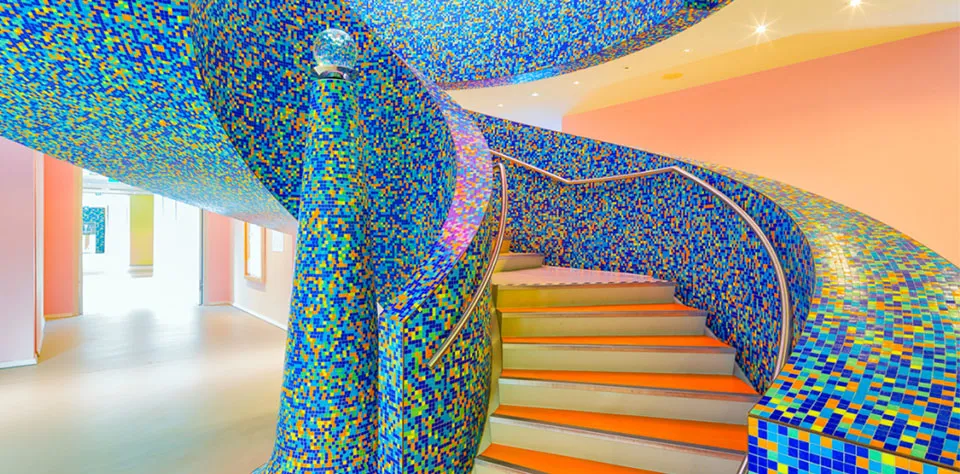16th August, On this Day
Alessandro Mendini (1931-2019) was a cultural provocateur who fundamentally transformed how we understand the relationship between art, design, and everyday life. Through his vibrant aesthetic philosophy and radical design theories, Mendini challenged the rigid orthodoxies of modernism and helped birth the postmodern design movement that continues to influence creators worldwide.
Born in Milan on August 16, 1931, Mendini graduated from Politecnico di Milano in 1959 with a degree in architecture and worked as a designer with Marcello Nizzoli. His early career at the prestigious Nizzoli Associati studio, responsible for many of Olivetti’s most memorable products, provided him with a solid foundation in industrial design. However, it was his transition from practice to theory that would prove most transformative.

In 1970 he abandoned architectural design to focus on journalism, specializing, naturally, in architecture and design. This shift marked the beginning of his role as one of design’s most influential voices. He was editor of Casabella from 1970 to 1976, and the following year he founded Modo, which he led until 1979. That same year, Giò Ponti made him editor of Domus, and he held this position until 1985.
The Radical Design Pioneer
The 1970s positioned Mendini at the epicenter of design revolution. In the 1970s Mendini was one of the main personalities of the Radical design movement. He became one of the founding members of the “Global Tools” collective, which was set up in 1973. This movement rejected the functionalist dogma that had dominated design for decades.
Starting in the 1970s, Mendini became a force behind a design revolution that rejected spare, rational modernism in favor of design inspired by decoration, humor, and even the banal objects of contemporary life. His approach was both intellectual and playful, challenging the notion that good design must be serious, minimal, and purely functional.
Studio Alchimia and the Birth of Postmodernism
In 1978 he joined the Studio Alchimia as a partner and there he worked with Ettore Sottsass and Michele De Lucchi. Studio Alchimia became the laboratory for what would become postmodern design. Alchymia made connections with artists, explored radical ideas about fashion, and staged theatrical happenings and events in its gallery.
With designers Ettore Sottsass and Michele De Lucchi, Mendini co-founded Studio Alchimia in 1976. He and Sottsass were among the founders of the Memphis group in 1980. These collectives would reshape the design landscape, proving that objects could be simultaneously functional and deeply expressive.
The Proust Armchair: A Manifesto in Furniture
Mendini’s most iconic creation, the Poltrona di Proust (1978), embodies his philosophy. Mendini purchased a replica of an eighteenth-century baroque armchair and covered it in fabric on which he hand-painted pointillist dots inspired by a painting by Signac. This piece exemplified his concept of “re-design”—transforming existing objects through artistic intervention.

For the “Proust” armchair Mendini selected a ready-made Rococo revival chair and had it hand-painted with Pointillist brushstrokes derived from a painting by nineteenth-century French painter Paul Signac. The chair became more than furniture; it was a statement about the intersection of art, literature, and design.
The piece’s evolution demonstrates Mendini’s vision of design as living culture. Since 1978 the Proust Armchair has been made in a succession of variants in new colours and materials. It has even been made in ceramics and bronze, and has travelled the world over.
Architectural Vision: The Groninger Museum
Mendini’s architectural masterpiece, the Groninger Museum in the Netherlands (1994), stands as a monument to postmodern principles. Client Frans Haks, director of the museum at the time, and architect and designer Alessandro Mendini created a true monument of postmodernism in the water of the connecting canal on the edge of downtown Groningen.

The building challenged conventional museum design with its bold, fragmented aesthetic. Right from the outset, it was certain that the new Groninger Museum would be designed by several architects. Alessandro Mendini chose designers and architects for this purpose: Philipe Starck, Michele de Lucchi and Coop Himmelb(l)au.
His best-known, and arguably most divisive, design is the whimsical, anthropomorphic Anna G corkscrew, which he created for the Italian brand in 1994. Evoking the form of a smiling woman wearing a dress, it remains one of Alessi’s most recognisable products.

Designed by Alessandro Mendini
Mendini’s theoretical contributions were as significant as his objects. Just as works of the Renaissance period expressed human values and sensibilities, Mendini contributed to bringing into the heart of design those “values” and “sensibilities” that have been eclipsed by commercialism and functionalism.
His approach to design was fundamentally humanistic. His design work was about strong ideas, rather than about formal or tactile qualities. He can be credited with developing the concept of re-design, through which everyday objects are reinterpreted in a way that is sometimes alien to their original function or style. This concept fundamentally changed how designers approached their craft, encouraging them to see design as cultural commentary.
Alessandro Mendini passed away on February 18, 2019, but his revolutionary spirit continues to influence design. His vision of design as cultural discourse, his embrace of decoration and emotion, and his belief in the power of objects to carry meaning beyond their function have become fundamental principles of contemporary design.
Cover Image: Groninger Museum Designed By Alessandro Mendini – 1994
For further Reading
- Cooper Hewitt, Smithsonian Design Museum
- Groninger Museum
- Museum of Modern Art, New York
- Philadelphia Museum of Art
- Memphis Milano
- Alessi Archives
- Magis Design Company
- Academic and museum publications
Contributor





